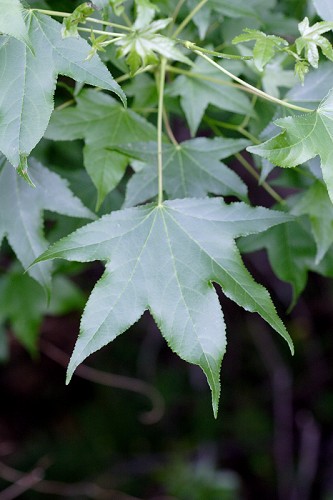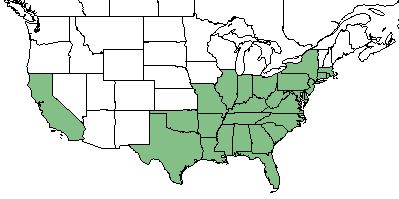Difference between revisions of "Liquidambar styraciflua"
Lsandstrum (talk | contribs) |
Lsandstrum (talk | contribs) |
||
| Line 32: | Line 32: | ||
==Ecology== | ==Ecology== | ||
===Habitat=== <!--Natural communities, human disturbed habitats, topography, hydrology, soils, light, fire regime requirements for removal of competition, etc.--> | ===Habitat=== <!--Natural communities, human disturbed habitats, topography, hydrology, soils, light, fire regime requirements for removal of competition, etc.--> | ||
| − | ''L. styraciflua'' is found in swamp forests, floodplains, moist forests, depressional wetlands, old fields, and disturbed areas. <ref name= "Weakley 2015"> Weakley, A. S. (2015). Flora of the Southern and Mid-Atlantic States. Chapel Hill, NC, University of North Carolina Herbarium. </ref> Specimens have been collected from hardwood swamp, lowland woodland, wet hammock, edge of lake, pine woods, mixed woodland, wet slash pine, sand bluffs, and edge of mesic woodland. <ref name = "FSU herbarium"> URL: http://herbarium.bio.fsu.edu. Last accessed: June 2018. Collectors: Cecil Slaughter, R.K. Godfrey, Kathy Craddock Burks, David A. Breil, Kurt Blum, Andre F. Clewell, Patricia Elliot, Gary Knight, A. Gholson Jr., Richard P. Wunderlin, Bruce Hansen, Karen MacClendon, Paul L. Redfearn, M.P. Burbank, Sherman, Shamblee, John W. Thieret, G.S. Ramseur, A.E. Hammond, Windler, M. Burch, Clarke Hudson, D.S. Correll, Raymond Jones, R. E. Wicker, Ed Keppner, Lisa Keppner, Richard Gaskalla, Ana Ochoa, Marc Minno. States and counties: Florida (Marion, Leon, Jefferson, Liberty, Walton, Dixie, Jackson, Santa Rosa, Levy, Hernando, Madison, Gadsden, Hillsborough, Wakulla, Calhoun, Osceola, Baker, St. Johns, Washington, Holmes) Georgia (THomasGrady, De kalb, Clarke) Arkansas (Stone, Searcy, Marion) North Carolina (Moore, Alamance) West Virginia (Cabell) Louisiana (Washington, Bienville, Evangeline, Tangipahoa, Lafayette, Lincoln) Tennessee (Coffee) Maryland (St. Marys) Mississippi (Forrest)</ref> ''L. styraciflua'' responds positively to soil disturbance by heavy silvilculture in North Carolina.<ref>Cohen, S., R. Braham, and F. Sanchez. (2004). Seed Bank Viability in Disturbed Longleaf Pine Sites. Restoration Ecology 12(4):503-515.</ref> When exposed to soil disturbance by military training in West Georgia, ''L. styraciflua'' responds negatively by way of absence.<ref>Dale, V.H., S.C. Beyeler, and B. Jackson. (2002). Understory vegetation indicators of anthropogenic disturbance in longleaf pine forests at Fort Benning, Georgia, USA. Ecological Indicators 1(3):155-170.</ref> | + | ''L. styraciflua'' is found in swamp forests, floodplains, moist forests, depressional wetlands, old fields, and disturbed areas. <ref name= "Weakley 2015"> Weakley, A. S. (2015). Flora of the Southern and Mid-Atlantic States. Chapel Hill, NC, University of North Carolina Herbarium. </ref> Specimens have been collected from hardwood swamp, lowland woodland, wet hammock, edge of lake, pine woods, mixed woodland, wet slash pine, sand bluffs, and edge of mesic woodland. <ref name = "FSU herbarium"> URL: http://herbarium.bio.fsu.edu. Last accessed: June 2018. Collectors: Cecil Slaughter, R.K. Godfrey, Kathy Craddock Burks, David A. Breil, Kurt Blum, Andre F. Clewell, Patricia Elliot, Gary Knight, A. Gholson Jr., Richard P. Wunderlin, Bruce Hansen, Karen MacClendon, Paul L. Redfearn, M.P. Burbank, Sherman, Shamblee, John W. Thieret, G.S. Ramseur, A.E. Hammond, Windler, M. Burch, Clarke Hudson, D.S. Correll, Raymond Jones, R. E. Wicker, Ed Keppner, Lisa Keppner, Richard Gaskalla, Ana Ochoa, Marc Minno. States and counties: Florida (Marion, Leon, Jefferson, Liberty, Walton, Dixie, Jackson, Santa Rosa, Levy, Hernando, Madison, Gadsden, Hillsborough, Wakulla, Calhoun, Osceola, Baker, St. Johns, Washington, Holmes) Georgia (THomasGrady, De kalb, Clarke) Arkansas (Stone, Searcy, Marion) North Carolina (Moore, Alamance) West Virginia (Cabell) Louisiana (Washington, Bienville, Evangeline, Tangipahoa, Lafayette, Lincoln) Tennessee (Coffee) Maryland (St. Marys) Mississippi (Forrest)</ref> ''L. styraciflua'' responds positively to soil disturbance by heavy silvilculture in North Carolina.<ref>Cohen, S., R. Braham, and F. Sanchez. (2004). Seed Bank Viability in Disturbed Longleaf Pine Sites. Restoration Ecology 12(4):503-515.</ref> When exposed to soil disturbance by military training in West Georgia, ''L. styraciflua'' responds negatively by way of absence.<ref>Dale, V.H., S.C. Beyeler, and B. Jackson. (2002). Understory vegetation indicators of anthropogenic disturbance in longleaf pine forests at Fort Benning, Georgia, USA. Ecological Indicators 1(3):155-170.</ref> It exhibits no response to soil disturbance by improvement logging in Mississippi.<ref>McComb, W.C. and R.E. Noble. (1982). Response of Understory Vegetation to Improvement Cutting and Physiographic Site in Two Mid-South Forest Stands. Southern Appalachian Botanical Society 47(1):60-77.</ref> |
===Phenology=== <!--Timing off flowering, fruiting, seed dispersal, and environmental triggers. Cite PanFlora website if appropriate: http://www.gilnelson.com/PanFlora/ --> | ===Phenology=== <!--Timing off flowering, fruiting, seed dispersal, and environmental triggers. Cite PanFlora website if appropriate: http://www.gilnelson.com/PanFlora/ --> | ||
Revision as of 19:54, 18 July 2019
Common name: sweetgum [1], red gum [2]
| Liquidambar styraciflua | |
|---|---|

| |
| Photo by the Southeastern Flora Database | |
| Scientific classification | |
| Kingdom: | Plantae |
| Division: | Magnoliophyta - Flowering plants |
| Class: | Magnoliopsida - Dicots |
| Order: | Hamamelidales |
| Family: | Hamamelidaceae |
| Genus: | Liquidambar |
| Species: | L. styraciflua |
| Binomial name | |
| Liquidambar styraciflua L. | |

| |
| Natural range of Liquidambar styraciflua from USDA NRCS Plants Database. | |
Contents
Taxonomic Notes
Synonyms: none
Varieties: none
Description
L. styraciflua is a perennial tree of the Hamamelidaceae family native to North America. [1]
Distribution
L. styraciflua is found in the southeastern corner of the United States from Texas to Massachusetts, as well as California. [1]
Ecology
Habitat
L. styraciflua is found in swamp forests, floodplains, moist forests, depressional wetlands, old fields, and disturbed areas. [2] Specimens have been collected from hardwood swamp, lowland woodland, wet hammock, edge of lake, pine woods, mixed woodland, wet slash pine, sand bluffs, and edge of mesic woodland. [3] L. styraciflua responds positively to soil disturbance by heavy silvilculture in North Carolina.[4] When exposed to soil disturbance by military training in West Georgia, L. styraciflua responds negatively by way of absence.[5] It exhibits no response to soil disturbance by improvement logging in Mississippi.[6]
Phenology
L. styraciflua has been observed flowering in February, March, and May. [7]
Fire ecology
L. styraciflua is quite fire resistant. [8]
Use by animals
L. styraciflua has medium palatability for browsing animals [1], and the bark is a favorite food of beavers. Additionally, the sap used to be gathered as chewing gum. [2]
Conservation and Management
L. styraciflua is listed as a species of special concern by the Connecticut Department of Environmental Protection. [1]
Cultivation and restoration
Photo Gallery
References and notes
- ↑ 1.0 1.1 1.2 1.3 1.4 USDA Plant Database https://plants.usda.gov/core/profile?symbol=LIST2
- ↑ 2.0 2.1 2.2 Weakley, A. S. (2015). Flora of the Southern and Mid-Atlantic States. Chapel Hill, NC, University of North Carolina Herbarium.
- ↑ URL: http://herbarium.bio.fsu.edu. Last accessed: June 2018. Collectors: Cecil Slaughter, R.K. Godfrey, Kathy Craddock Burks, David A. Breil, Kurt Blum, Andre F. Clewell, Patricia Elliot, Gary Knight, A. Gholson Jr., Richard P. Wunderlin, Bruce Hansen, Karen MacClendon, Paul L. Redfearn, M.P. Burbank, Sherman, Shamblee, John W. Thieret, G.S. Ramseur, A.E. Hammond, Windler, M. Burch, Clarke Hudson, D.S. Correll, Raymond Jones, R. E. Wicker, Ed Keppner, Lisa Keppner, Richard Gaskalla, Ana Ochoa, Marc Minno. States and counties: Florida (Marion, Leon, Jefferson, Liberty, Walton, Dixie, Jackson, Santa Rosa, Levy, Hernando, Madison, Gadsden, Hillsborough, Wakulla, Calhoun, Osceola, Baker, St. Johns, Washington, Holmes) Georgia (THomasGrady, De kalb, Clarke) Arkansas (Stone, Searcy, Marion) North Carolina (Moore, Alamance) West Virginia (Cabell) Louisiana (Washington, Bienville, Evangeline, Tangipahoa, Lafayette, Lincoln) Tennessee (Coffee) Maryland (St. Marys) Mississippi (Forrest)
- ↑ Cohen, S., R. Braham, and F. Sanchez. (2004). Seed Bank Viability in Disturbed Longleaf Pine Sites. Restoration Ecology 12(4):503-515.
- ↑ Dale, V.H., S.C. Beyeler, and B. Jackson. (2002). Understory vegetation indicators of anthropogenic disturbance in longleaf pine forests at Fort Benning, Georgia, USA. Ecological Indicators 1(3):155-170.
- ↑ McComb, W.C. and R.E. Noble. (1982). Response of Understory Vegetation to Improvement Cutting and Physiographic Site in Two Mid-South Forest Stands. Southern Appalachian Botanical Society 47(1):60-77.
- ↑ Nelson, G. PanFlora: Plant data for the eastern United States with emphasis on the Southeastern Coastal Plains, Florida, and the Florida Panhandle. www.gilnelson.com/PanFlora/ Accessed: 24 MAY 2018
- ↑ Brockway, D. G., et al. (2005). Restoration of longleaf pine ecosystems. F. S. United States Department of Agriculture, Southern Research Station.